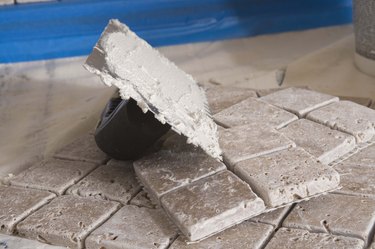 Tile is a heavy material and is sensitive to movement.
Tile is a heavy material and is sensitive to movement.
Tile can be installed on virtually any vertical or horizontal surface, provided that the proper surface preparation is done. With a few simple steps the side of a cabinet can be a perfectly suitable location to install a tile backsplash.
Video of the Day
Backer Board
The wooden, or more likely veneered, side of a cabinet will not provide the necessary support for tile on its own. For this reason, add a layer of 1/4-inch cement board cut to the dimensions of the side of the cabinet. Attach the cement board using a combination of concrete adhesive in the middle and concrete board screws around the outside edge where they can be driven into the cabinet frame.
Protect the Surrounding Area
Tiling is a messy job, particularly when it is done on a vertical surface. Before starting to lay the tile put down a protective drop cloth or layer of plastic to cover the floor and countertop, and mask off adjoining walls or cabinets with plastic and painter's tape.
Tiling a Vertical Surface
Tiling a vertical surface is slightly more difficult than laying tiles flat, because, until the thinset dries, the tiles will still move up and down and side to side. If the backsplash is being installed on a floor cabinet, the first course of tiles can be supported directly at the floor, and additional courses will rest on top of that first course using tile spacers. This will keep everything supported until the thinset dries. However, for upper cabinets, this is not an option. A reliable and inexpensive option for supporting the tiles is to clamp a 1-by-2-inch board to the base of the cabinet and rest the first course of tiles on that board. As long as the board is level it will provide a guide for leveling each additional course, and it will prevent tiles from slipping. Check the board regularly with a level to make sure it hasn't moved.
Wrapping It Up
The rest of the tile job is just like installing tile anywhere else. Because a backsplash is subjected to moisture, food and chemicals, it is important that it be sealed with a high quality tile sealer two or three times per year. This will prevent staining and will make regular cleanup much easier.


